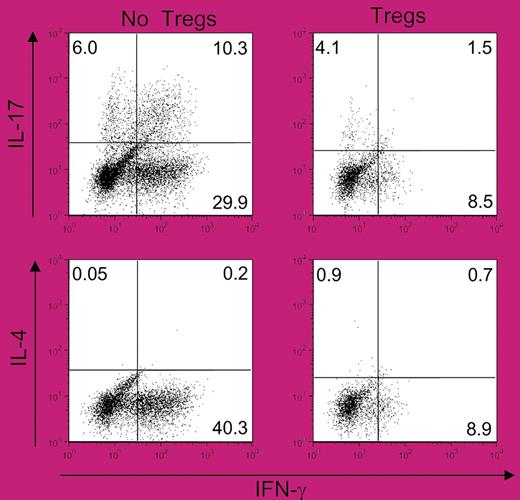Failure of the CD4+CD25+Foxp3+ regulatory T-cell compartment to control immune reactivity to self-antigens leads to the development of chronic graft-versus-host disease largely mediated by donor-derived helper T cells that secrete pro-inflammatory cytokines.
Graft-versus-host disease (GVHD) remains the major complication of allogeneic bone marrow transplantation (BMT). This posttransplantation complication initially presents as an acute inflammatory response in donor-derived T cells that respond to histocompatibility antigens differentially expressed by the recipient. This can evolve into a chronic systemic disease that shares clinical characteristics with several collagen vascular autoimmune disorders, including Sjogren syndrome and scleroderma; how-ever, the immune mechanisms that underlie chronic GVHD have remained elusive and enigmatic. Chronic GVHD was originally thought to be due to persistent recognition of antigenic tissue differences (allogeneic) between donor and host, leading to the characteristic pathology of this disorder.1 On the other hand, detection of autoreactive T cells in recipients with chronic GVHD led to the hypothesis that the development of autoreactive donor T cells is due to thymic dysfunction.2 In addition, it appears that autoreactive T cells can manifest autoaggression only in an environment deficient of regulatory T cells.2,3
In this issue of Blood, an elegant series of studies by Chen and colleagues identifies a potential mecahnism for explaining this hypothesis by providing evidence that the absence of CD4+CD25+Foxp3+ regulatory T cells is critical for the development of chronic GVHD. The presence of the regulatory T cells prevents the development of chronic GVHD, whereas the absence of the regulatory T-cell compartment permits the expansion of donor-derived autoreactive CD4+ T cells with Th1 and Th17 cytokine phenotypes (see figure). These autoreactive T cells induce the release of proinflammatory cytokines that cause autoimmune pathology. In this regard, IL-17 is often associated with a variety of autoimmune disorders, and induces epithelial, endothelial, and stromal cells to produce proinflammatory cytokines. Of additional interest is the finding that autoreactive T cells can be detected early after transplantation during acute GVHD. Thus, the initial immunological events leading to chronic GVHD appear to be set in motion during the acute phase of GVHD. These findings may help to explain the highly predictive association of acute GVHD with the development of chronic GVHD.2
Autoimmunity is characterized by TH1- and TH17-mediated proinflammatory cytokine production that is suppressed by CD4+CD25+Foxp3+ T cells.
Autoimmunity is characterized by TH1- and TH17-mediated proinflammatory cytokine production that is suppressed by CD4+CD25+Foxp3+ T cells.
Resolution of acute GVHD or the progression to chronic GVHD appears to be clearly dependent on the reconstitution and the activation of the CD4+CD25+Foxp3+ regulatory T-cell compartment. In this issue of Blood, an emergent therapeutic strategy to prevent chronic GVHD by enhancing the regulatory compartment is described in the article by Fujita and colleagues. Administration of recipient-derived dendritic cells specifically modified by culture in GM-CSF, IL-10, and TGFβ, followed by LPS stimulation, suppressed the development of cutaneous chronic GVHD. Moreover, the transfer of modified dendritic cells was associated with the expansion of the CD4+CD25+Fox3+ regulatory T-cell compartment. Interestingly, it appears that the modified dendritic cells could also be utilized to drive the activation of regulatory T cells in an antigen-specific manner. In addition to the potential to prevent chronic GHVD after allogneiec BMT, these studies suggest that other undesirable immune responses might be directed by modification of the antigen-presenting cell.
Over the past few years, a number of studies have provided unique insights into the autoimmune effector and regulatory immune mechanisms that underlie chronic GVHD, a challenging clinical problem. Recognition of self and the regulation of the immune response to self play key roles in this process. While the antigen specificity of the effector and regulatory T cells still remains unclear, improved understanding of the underlying mechanisms promises to lead to exciting new therapeutic strategies.
Conflict-of-interest disclosure: The author declares no competing financial interests. ■



